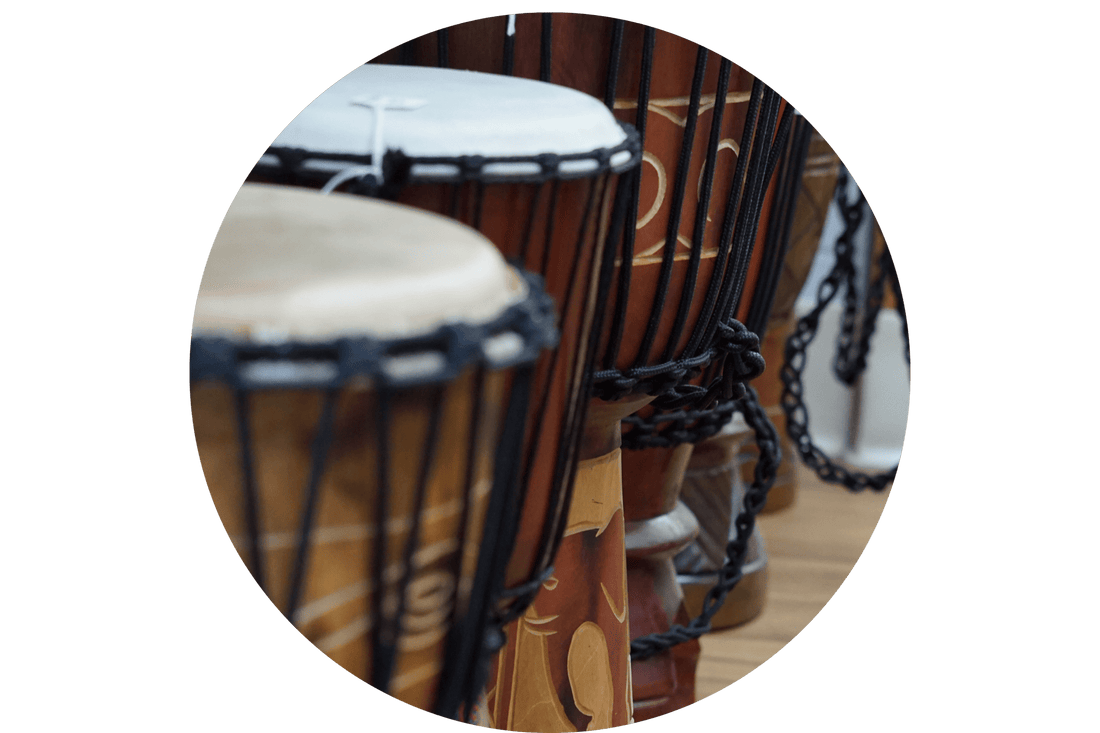
When buying a djembe there are a few important things to look for.
I own a business that does a lot of djembe repairs. From so much volume we have learned a lot and have observed some questionable advice being given to would-be purchasers.
Here are some things that you should keep in mind when buying a djembe.
1. Bearing Edge
AVOID: a bearing edge less than a half-inch high.

The bearing edge is the top edge of the drum that makes direct contact with the head.
Anything less than a curved, routered half-inch size edge can hurt your hands after a short time of playing. Flat edges can reduce the sound intensity.
2. Sound vs Weight
Next, let’s look at the djembe’s shell. Typically, djembes made of hardwood such as Mahogany (like our Pro Series djembes), Iroko (Ivory Coast djembes), and Lenke (Guinea, Senegal, and Mali djembes) give superior sound and projection. That said, sound quality is subjective and I have heard some great softwood Ghana drums. One downside of wooden drums is their weight.

Composite djembes are much lighter, making them great for children and seniors (plus, they come in a variety of colours and designs!). However, their sound projection is not as intense. That said, weather and temperature do not affect their tuning if the drum has a fibreskin head. These are tough and practical djembes.

Finally, composite djembes with air vents are fantastic as an ensemble drum. They are lightweight and feature air holes to allow for greater projection without the need to lift the drum off the floor. This is the best option for ensembles and children.

3. Rope Quality
Good rope quality is essential. This is an area some African drums often fall behind. The best rope has a core to prevent stretching and constant re-tuning. The manufacturer who makes virtually all of the superior Indonesian drums in North America uses an excellent rope.

4. Head Quality

Goat skins are usually preferred to other animal skins. They are the perfect combination of durable and flexible, with a thickness that lends to an authentic djembe sound.
African goat skins from Guinea, Mali, and Ivory Coast tend to be thicker and stronger. Ghana skins are often thinner because they use the “pigmy” goat breed. This small goat is tough and gives a bigger and longer-sustaining bass sound. These are excellent for drums with 11” heads and smaller.
North American goat is stretchy and, in my opinion, almost unusable. If the skins are imported by air shipments, the veterinarian certificate is not required. It is good to ask how the skins or drums arrived for this reason.
Pakistani skins tend to be thinner and may break easier. However, they are less expensive and work well for small drums.
The best skins I have used are the ones from the Indonesian Pro Series djembes. They are more expensive, though there are cheaper Indonesian skins comparable to the Pakistani ones. However, you can tell the difference immediately by sound and their manufactured look. These heads have been veterinarian-inspected.
Fibreskin heads are vegan and used on our composite & Air Drum models. They are high-quality, incredibly tough, and create a bright sound. They are also less vulnerable to being de-tuned from weather and temperature changes. However, they lack the projection sought by many wanting an authentic djembe sound. TIP: Place a small piece of sticky tack on the inside of the head to give a dryer, goat-skin-like sound.
NOTE: For all African skins, check to see if air-shipped or shipped by sea. Sea shipments require veterinarian inspections for anthrax (anthrax cases are extremely rare, however). Pakistani skins typically have no need for inspections because they are chemically de-haired.
Haired or non-haired skins?

I stopped using haired skins because of the North American pantry moth. These pests can turn a beautiful drum into a mess in a few weeks. Since I work in schools where hygiene and safety are a must, I avoid hair altogether.

5. Lug vs Rope Tune
Rope-tuned djembes are the traditional method of tuning. They are typically tuned with a Mali weave roping style. Once you learn to rope-tune the drum, it is quite easy. Repairs on rope-tuned drums are labour-intensive and expensive. Not many people know how to repair them.


Lug-tuned djembes (also called key-tuned djembes) are very easy to tune and repair—just a matter of tightening the lugs with a wrench. They are becoming more popular because they are so easy to service. However, when holding them they can sometimes be uncomfortable if the lugs are against your legs.


That’s all for now! If you feel I have missed anything, comment down below. Who knows, maybe I’ll make a part 2...?
Written by Milton Randall, Owner of Empire Music Co.

